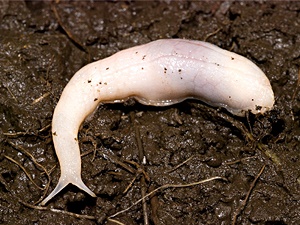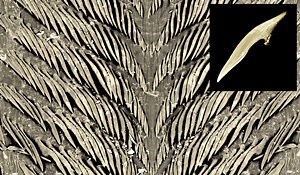
Welsh ghost slug (Selenochlamys ysbryda).
Picture: National Museum Wales (Source). (

Radula and single radula tooth of Selenochlamys ysbryda.
EM-Picture: National Museum Wales (Source). (
Selenochlamys ysbryda Rowson & Symondson, 2008
 Welsh ghost slug (Selenochlamys ysbryda). Picture: National Museum Wales (Source). ( |
|
 Radula and single radula tooth of Selenochlamys ysbryda. EM-Picture: National Museum Wales (Source). ( |
|
|
Their subterranean way of life made it necessary for carnivorous snails hunting earthworms underground to undergo numerous adaptations. So the Daudebardiinae have strongly reduced their shell in favour of better movability, but at the cost of not being able to withdraw into a shell anymore. Even further advanced is the shell reduction in shelled slugs (Testacellidae), whose shell is tiny and clam-like sitting on the back's tail end, resembling the shell of a sea-living abalone (Haliotidae). When hunting for earthworms underground, shelled slugs withdraw their obstructing and vulnerable tentacles. They cannot see anything anyway.
It was not until 2006 that in Wales a snail species was found that had evaded science due to its living underground and which was given the scientific name Selenochlamys ysbryda Rowson & Symondson in 2008. The species' name is derived from the Welsh word 'ysbryd' for a ghost, and indeed the snail does have a somewhat ghost-like appearance, being white and translucent due to its subterranean way of life.
Shell reduction is even further advanced in the ghost snail than in shelled slugs: Selenochlamys is a complete slug without any trace of an exterior shell. Other than in common European slugs, however, the respiratory hole is located at the end of the body, like in a Testacella, where the shell would be in that kind of snail.
Also, in ghost snails, the eyes are reduced, which would be of little use to an animal living underground. Like other subterranean snails, eg. the blind snail (Ceciliodes acicula), Selenochlamys has four tentacles, but no eyes.
Similar to other carnivorous snail groups (like the already mentioned Testacellas, Daudebardias and the Dalmatian predator (Poiretia cornea), see: Snail nutrition II), a ghost snail's radula teeth are also adapted to the carnivorous way of feeding: Dagger-like radula teeth make it easier for the snail to grab earthworms and to pull them into its mouth, even when they resist. It is also reasonable to assume that Selenochlamys swallows the earthworm whole, as a Daudebardia or Testacella does.
The first specimen of the ghost snail most suitably was found in a churchyard in Brecon, Wales. Further specimens were later found in other places in Wales. From there, the ghost snail has been spreading throughout Wales, where it might even become an agrarian pest, due to its feeding on earthworms (Sally Williams: Worm-eating 'ghost' slug is advancing across Wales. Wales Online (2012), accessed 13.09.2022).
It is generally assumed that Selenochlamys ysbryda is an introduced
species (neozoon), which might have reached Britain with potted plants (![]() Finding site in Wales - new window).
Finding site in Wales - new window).
The ghost snail's nearest relatives from the Trigonochlamydidae family live in Turkey and Georgia (Selenochlamys pallida). Specimens of Selenochlamys, found on the Crimea peninsula in Ukraine in 2012 and 2015, have been distinguished anatomically from Selenochlamys pallida and likewise determined as Selenochlamys ysbryda, which is why it is assumed the species might have originated from the Crimea peninsula.
Literature:
| Balashov, I. (2012): "Selenochlamys ysbryda in the Crimean Mountains, Ukraine: first record from its native range?". Journal of Conchology. 41 (2): 141–144. | |
| Rowson, B., Symondson, B. (2008): Selenochlamys ysbryda sp. nov. from Wales, UK: a Testacella-like slug new to western Europe (Stylommatophora: Trigonochlamydidae). Journal of Conchology, 39(5): 537–552. | |
| Turbanov, I.; Balashov, I. (2015). "A second record of Selenochlamys (Stylommatophora: Trigonochlamidae) from Crimea" (PDF). Malacologia Bohemoslovaca. 14: 1–4. |